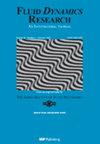The 14th FDR prize
IF 1.3
4区 工程技术
Q3 MECHANICS
引用次数: 0
Abstract
Steady flow in a rapidly rotating spheroid with weak precession: I Shigeo Kida Vol. 52, No. 1, 015513 (2020) The flow in a rotating spheroidal container that executes precession has long attracted attention as a model for pursuing the origin of the dynamos of celestial bodies including the geodynamo. In recent years, research has been made from the viewpoint of generating a compact turbulence and utilizing it for efficient mixer (Goto et al 2007). The first key result is a steady inviscid solution heuristically derived by Poincaré (1910), which is a uniform vorticity state with the velocity field linear in coordinates; a spheroidal container filled with an inviscid fluid rapidly rotating around the axis of symmetry (referred to as the x axis) precesses around another axis (referred to as the z axis) perpendicular to the symmetric axis. The vorticity, relative to the spinning spheroid, is parallel to the z axis for an oblate spheroid but is antiparallel for a prolate spheroid. In between, there is no special direction for a spherical container, for which the magnitude of the vorticity diverges. To rescue this difficulty, Busse (1968) made an attempt at incorporating the effect of the boundary layer on the vessel by using the integral balance of torque, but his treatment turned out to be incomplete. This paper has resolved the problem of singularity by making a precise perturbation analysis of the boundary layer. There are three parameters in this problem, the aspect ratio c= b/a of the spheroid with the axis length 2 b and the equatorial length a, the Poincaré number Po=Ωp/Ωs, being the ratio of the precession angular velocity Ωp to the angular velocity Ωs of the main spin, and the Reynolds number Re= aΩs/ν, with ν being the kinematic viscosity of fluid. For a spheroid close to a sphere |c− 1| ≪ 1, a boundary-layer solution is constructed in the region of Po≪Max(Re−1/2, |c− 1|) (the obtained solution requests |c− 1| ≪ Re−1/2). Introducing ellipsoidal coordinates in the ‘rigidly rotating system’ with the X axis parallel to the full angular velocity vector ω̄, a solution is constructed in the form of perturbations in powers of a small parameter ε̄, a measure of the magnitude of the deviation flow, in such a way that the boundary-layer solution smoothly matches to the solution in the inviscid region. Unknown parameters are the three components of the perturbation of the angular velocity due to precession. For the spherical case (c= 1), these remain undetermined. The balance of the total torque is invoked, consisting of the integrals of the pressure, the precession-induced Coriolis force, and the viscous stress. Busse (1968) carried out this procedure to O(ε̄), which is insufficient for obtaining the correction term c̄ of the x component of the angular velocity. This paper has gained the axisymmetric component c̄ for the first time by including, in the torque, the circumferential average of the nonlinear boundary-layer solution of O(ε̄2). Without this term, the total angular velocity |ω̄| is not obtained correctly. The correction c̄ takes a significant value only when the container is close to a sphere (|c− 1| ≈ Re−1/2), and is indispensable for describing how the perturbation vorticity vector flips from negative to positive z direction when the spheroidal shape changed from prolate to oblate. Moreover, a mathematical proof is given for the uniqueness of the stationary inviscid solution.第14届罗斯福奖
具有弱进动的快速旋转球体中的稳定流动:I Shigeo Kida Vol.52,No.1,015513(2020)执行进动的旋转球体容器中的流动长期以来一直作为一种模型引起关注,用于寻找包括地球动力学在内的天体的发电机的起源。近年来,人们从产生紧凑湍流并将其用于高效混合器的角度进行了研究(Goto等人,2007年)。第一个关键结果是Poincaré(1910)启发式推导的稳定无粘解,它是一个均匀涡度状态,速度场在坐标系中是线性的;填充有围绕对称轴(称为x轴)快速旋转的无粘性流体的球形容器围绕垂直于对称轴的另一个轴(也称为z轴)进动。相对于旋转球体,对于扁球体,涡度平行于z轴,但对于长球体,涡量反平行。在这两者之间,对于一个球形容器来说,并没有特殊的方向,因为它的涡度大小是发散的。为了解决这一困难,Busse(1968)试图通过使用扭矩的积分平衡来结合边界层对船舶的影响,但他的处理结果是不完整的。本文通过对边界层进行精确的摄动分析,解决了奇异性问题。这个问题有三个参数,轴长为2b、赤道长度为a的球体的纵横比c=b/a,庞加莱数Po=Ωp/Ωs,是进动角速度Ωp与主自旋角速度Ωs的比值,雷诺数Re=aΩs/Γ,其中Γ是流体的运动粘度。对于靠近球体|c−1|≪1的球体,在Po \8810;Max(Re−1/2,|c−1\|)区域构造边界层解(获得的解要求|c−1 |Re−1/2)。在X轴平行于全角速度矢量ω̄的“刚性旋转系统”中引入椭球坐标,以小参数ε\772的幂扰动的形式构建了一个解,ε̄是偏差流大小的度量,以使边界层解与无粘性区域的解平滑匹配。未知参数是由于进动引起的角速度扰动的三个分量。对于球形情况(c=1),这些仍然是不确定的。调用总扭矩的平衡,包括压力、进动引起的科里奥利力和粘性应力的积分。Busse(1968)对O(ε̄)进行了这一过程,这不足以获得角速度x分量的校正项c \772。本文首次通过在力矩中包含O(ε2)的非线性边界层解的周向平均值,获得了轴对称分量c̄。如果没有这个项,就不能正确地获得总角速度|ω̄|。只有当容器靠近球体时(|c−1|≈Re−1/2),校正c̄才具有显著值,并且对于描述当球体形状从扁长变为扁长时扰动涡度矢量如何从负向正z方向翻转是必不可少的。此外,还给出了定常无粘解的唯一性的数学证明。
本文章由计算机程序翻译,如有差异,请以英文原文为准。
求助全文
约1分钟内获得全文
求助全文
来源期刊

Fluid Dynamics Research
物理-力学
CiteScore
2.90
自引率
6.70%
发文量
37
审稿时长
5 months
期刊介绍:
Fluid Dynamics Research publishes original and creative works in all fields of fluid dynamics. The scope includes theoretical, numerical and experimental studies that contribute to the fundamental understanding and/or application of fluid phenomena.
 求助内容:
求助内容: 应助结果提醒方式:
应助结果提醒方式:


